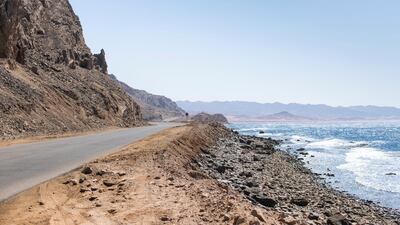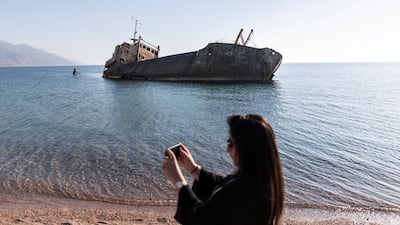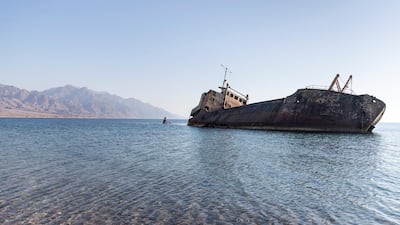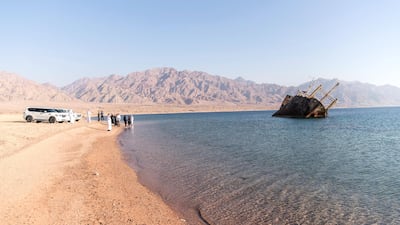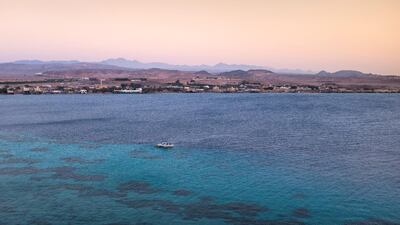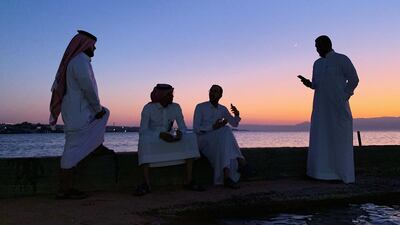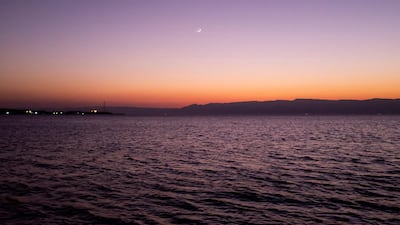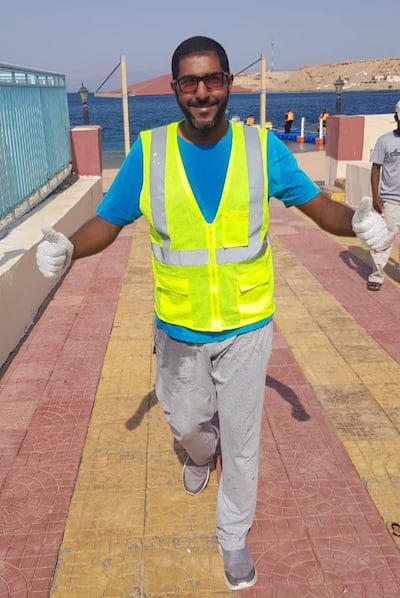A lone settlement sits right at the northernmost tip of Saudi Arabia’s Red Sea coastline. Its smattering of buildings seem to be at various stages of development – some still under construction, some stalled. A few locals stroll through the desert streets of Haql on a Monday evening as the sun sets. Dramatic cliffs frame the town’s beachfront location, tumbling into an untouched sea. It’s quiet in early October. There are no tourists here.
One lone hotel operates in the area, offering small-scale snorkelling trips and boat rides into the famed Red Sea waters, where just a few kilometres to the east, across the Gulf of Aqaba, well-serviced and developed resort towns welcome thousands of holiday goers each week.
Amjad AlSanousi, the owner of the Hayat Haql Hotel, hopes that Saudi opening its doors to the world means that this will change.
“Because of the weather, each year, we have six months without work,” he says. “There are a lot of weeks without guests.”
Say the words “Red Sea” to anyone and you’ll likely evoke images of resorts and dive trips, and high-end oceanfront real estate full of holidaymakers jostling for a sun lounger. But say it to a Saudi, and you’ll be met with descriptions of a dramatic, rocky coastline sprawling for hundreds of kilometres, sparsely populated and devoid of life, yet still sharing these same famed waters.
These tumbling cliffs and clear waters, brimming with a thriving marine ecosystem, have until now been largely off-limits to tourists - meaning the coral is vibrant, the fish species are diverse (lion fish are regularly spotted just off the beach), and the locals are overjoyed at a foreign face.
Saudi Arabia’s Red Sea coastline stretches 2,400 kilometres in total, from Haql and the Gulf of Aqaba in the north, to the Saudi-Yemeni border in the south.
Across the water lies Egypt’s Sinai Peninsula, and the well-known and built up resort towns of Dahab and Sharm El Sheikh. The area is known for some of the best diving in the world; at the height of its popularity, Sharm El Sheikh was said to have 9,000 British tourists a day sunning themselves on the beach or taking in the pristine waters.
And yet, barely 20 kilometres across the Gulf of Aqaba, the Saudi Arabian stretch of those same clear and abundant waters sit virtually ignored. Aside from the small settlements of Haql in the north, and Sharma in the south, the coastline is untouched, save for a few smatterings of houses and a shipwreck turned local attraction. Seemingly just one dive centre exists here, operating a monopoly on the diverse marine life and crystal-clear waters that divers flock to Sharm El Sheikh for in their droves.
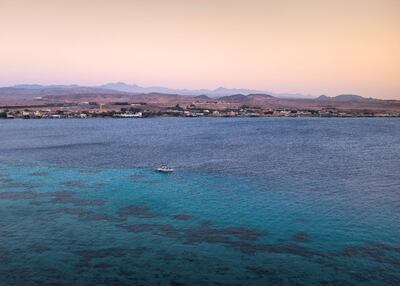
AlSanousi grew up in Haql, when there was “nothing here”. He and his two brothers built the Hayat Haql Hotel ten years ago; a small, lime-green building sitting on a small stretch of sand. They put in a small marina and a floating wharf, and have a small boat to take visitors out for a hoon around the bay. Five years after that, some other enterprising locals in the area somewhat followed suit, slowly growing the town from a tiny village to something of a functioning town, he says. But tourists, and business, remained elusive. Haql seems to have tried to take advantage of its envious position, but success has so far eluded it.
Sitting five kilometres south of the Jordanian border, and with the borders of Israel and Egypt lying a few kilometres beyond that, competition has been fierce. The town of Aqaba (Eilat on the Egyptian side) is a popular crossing point for tourists between Israel and Jordan, and has meant it is the sole thriving town in the area. Even AlSanousi admits it’s his place of choice in the area for entertainment.
It was only two years ago that a steady stream of curious tourists began coming in. They are mostly travellers from Riyadh, he says, and sometimes even an international traveller or two. But the town remains a seasonal place to visit as six months of the year, when it's too hot, people simply don't come.
“Our problem is here we have Jordan, Aqaba, 12km from here, they have a lot of hotels and resorts there and the same area, same sea. Most people go there, even us,” he says.
“But I can’t close. I have put in too much money.”
The resort is mainly aimed at families and they choose not to take single travellers. This is simply due to cultural norms, AlSanousi says, and the other small accommodation offerings in the area are more suited to them. These are mostly small, closed-off chalets, walled off on all sides, where people can wade out into the waters undisturbed.
“I wanted to create something different here,” he says. “And if the people come, everything will be nice.”
Despite its isolated location, AlSanousi says female travellers should feel welcome to come. Abayas do not need to be worn, and his beach is private so it allows people to feel comfortable.
No doubt the coming years will see a decidedly different change in fortunes for Haql. The tourists will come for the untouched Red Sea marine life, and perhaps, the famed shipwreck.
The Georgios G shipwreck, otherwise known as the “Saudi Titanic”, is a favourite picture spot for those who make it out this far. Much like similar spots in Saudi Arabia, there is no sign to announce its existence, car park, or even toilet. You simply careen off the road in your Nissan Patrol, park up, and drive away again.
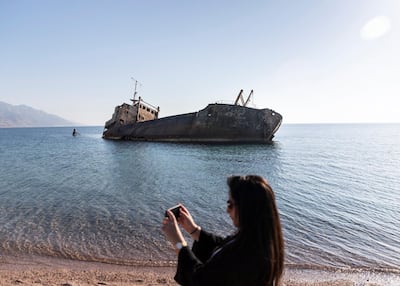
It’s a strange sight, this British-made cargo ship, which ran aground near Haql in 1978, and now sits half-submerged in the water. A strange sight which will no doubt, in a few years, be swarming with selfie sticks and keychain stalls.
"Along this whole 800 kilometre stretch of coast, there is no five-star resort," says our guide Farhan. You wonder if in five years time, he might be wishing that were the case.
But it won’t just be tourists who come, because this entire coastline is expected to soon transform entirely, as the futuristic new development of Neom takes shape. The $500 billion high tech city is being built on a site near here, and is expected to encompass most of this region. It will be more than 35 times the size of Singapore and will contain over 450km of coastline, including territory from the Egyptian and Jordanian borders, and spanning a total area of 26,500 square kilometres.
It’s unclear whether Haql will be swallowed up by the futuristic metropolis in its entirety. Whether the dramatic, rocky cliffs will give way to apartment buildings with panoramic views, whether the tiny beachside chalets will give way to glitzy five-star resorts, and whether the tiny, family-run hotels, like the Hayat Haql, will remain. Realistically, it’s probably inevitable. But until that day, AlSanousi will be here, taking plucky travellers out on to his tiny boat, and harbouring some of the most untouched coral and marine life in the world.
